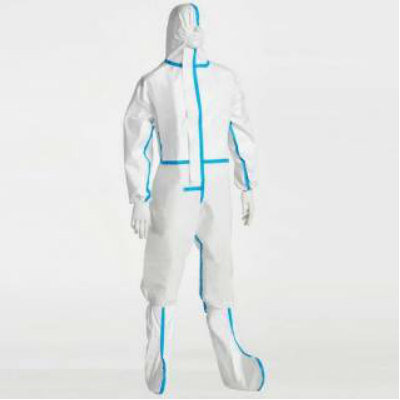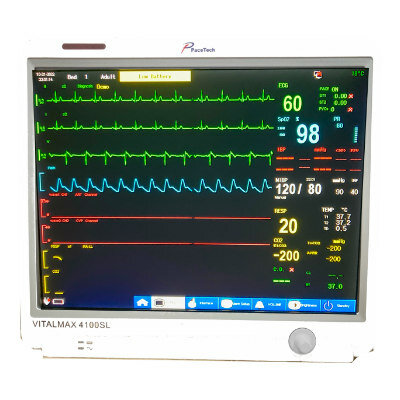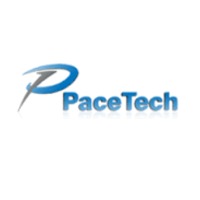Enhanced UV Technology Improves Hospital Infection Prevention 
|
By HospiMedica International staff writers Posted on 09 Jun 2014 |

Image: The TRU-D SmartUVC with iTRU-D in action (Photo courtesy of TRU-D).
An upgraded Ultraviolet C band (UV-C) disinfection robot performs automated pathogen disinfection of patient spaces.
The TRU-D SmartUVC with iTRU-D exploits Sensor360 technology for instant room analysis and dose calculation and delivery, eliminating the need to input room measurements, floor plans or diagrams needed to designate multiple robot positions, and increased labor costs due to the need to cover windows and vents. As a result, the TRU-D is able to disinfect an entire room—including shadowed spaces—from one location within the room, eliminating labor associated with continually moving it to multiple sites inside the room. The disinfection progress also ensures 3–4 log surface disinfection of pathogens in any space.
Cloud-based infection prevention data tracking technology provided by iTRU-D reports concurrent prevention, usage efficiency, and risk aversion data. The secure usage-tracking program also sends customized real-time infection prevention reports via an iPad Mini to hospital staff. Among the other features of the system are dose assurance delivered to direct and shadowed high touch surfaces, rapid room disinfection, and environmental safety, since UVC light is not transmitted through glass windows. The TRU-D SmartUVC portable disinfection robot with iTRU-D is a product of TRU-D (Memphis, TN, USA).
“We work closely with our customers to provide a product that fits their infection prevention needs. Second to providing an evidence base for consistent disinfection outcomes to insure patient safety, labor cost is the major consideration in the selection of no-touch room disinfection technology,” said Chuck Dunn, president of TRU-D. “TRU-D is validated by numerous third-party scientific studies proving that TRU-D's patented technology works to eradicate 99.9% of pathogens, which is what's most important to health care customers.”
UV-C light is a UV wavelength of 254 nm that induces the formation of pyrimidine dimers from thymine and cytosine; these dimers in turn cause disruptions in microbial DNA, making genetic replication impossible, thus destroying the organisms or rendering them unable to reproduce. The efficacy of the UV-C irradiation is a function of many different parameters, such as intensity, exposure time, lamp placement, and air movement patterns.
Related Links:
TRU-D
The TRU-D SmartUVC with iTRU-D exploits Sensor360 technology for instant room analysis and dose calculation and delivery, eliminating the need to input room measurements, floor plans or diagrams needed to designate multiple robot positions, and increased labor costs due to the need to cover windows and vents. As a result, the TRU-D is able to disinfect an entire room—including shadowed spaces—from one location within the room, eliminating labor associated with continually moving it to multiple sites inside the room. The disinfection progress also ensures 3–4 log surface disinfection of pathogens in any space.
Cloud-based infection prevention data tracking technology provided by iTRU-D reports concurrent prevention, usage efficiency, and risk aversion data. The secure usage-tracking program also sends customized real-time infection prevention reports via an iPad Mini to hospital staff. Among the other features of the system are dose assurance delivered to direct and shadowed high touch surfaces, rapid room disinfection, and environmental safety, since UVC light is not transmitted through glass windows. The TRU-D SmartUVC portable disinfection robot with iTRU-D is a product of TRU-D (Memphis, TN, USA).
“We work closely with our customers to provide a product that fits their infection prevention needs. Second to providing an evidence base for consistent disinfection outcomes to insure patient safety, labor cost is the major consideration in the selection of no-touch room disinfection technology,” said Chuck Dunn, president of TRU-D. “TRU-D is validated by numerous third-party scientific studies proving that TRU-D's patented technology works to eradicate 99.9% of pathogens, which is what's most important to health care customers.”
UV-C light is a UV wavelength of 254 nm that induces the formation of pyrimidine dimers from thymine and cytosine; these dimers in turn cause disruptions in microbial DNA, making genetic replication impossible, thus destroying the organisms or rendering them unable to reproduce. The efficacy of the UV-C irradiation is a function of many different parameters, such as intensity, exposure time, lamp placement, and air movement patterns.
Related Links:
TRU-D
Latest Critical Care News
- Deep-Learning Model Predicts Arrhythmia 30 Minutes before Onset
- Breakthrough Technology Combines Detection and Treatment of Nerve-Related Disorders in Single Procedure
- Plasma Irradiation Promotes Faster Bone Healing
- New Device Treats Acute Kidney Injury from Sepsis
- Study Confirms Safety of DCB-Only Strategy for Treating De Novo Left Main Coronary Artery Disease
- Revascularization Improves Quality of Life for Patients with Chronic Limb Threatening Ischemia
- AI-Driven Prediction Models Accurately Predict Critical Care Patient Deterioration
- Preventive PCI for High-Risk Coronary Plaques Reduces Cardiac Events
- AI Diagnostic Tool Guides Rapid Diagnosis and Prediction of Sepsis
- World's First AI-Powered Sepsis Alert System Detects Sepsis in One Minute
- Smartphone Magnetometer Uses Magnetized Hydrogel to Measure Biomarkers for Disease Diagnosis
- New Technology to Revolutionize Valvular Heart Disease Care
- Super Permeable Wearable Electronics Enable Long-Term Biosignal Monitoring
- New Hydrogel Features Enhanced Capabilities for Treating Aneurysms and Halting Progression
- New AI Tool Predicts Medical Events to Support Clinical Decision-Making in Healthcare Settings
- Bioelectronic Mesh Grows With Cardiac Tissues for Comprehensive Heart Monitoring
Channels
Artificial Intelligence
view channel
AI-Powered Algorithm to Revolutionize Detection of Atrial Fibrillation
Atrial fibrillation (AFib), a condition characterized by an irregular and often rapid heart rate, is linked to increased risks of stroke and heart failure. This is because the irregular heartbeat in AFib... Read more
AI Diagnostic Tool Accurately Detects Valvular Disorders Often Missed by Doctors
Doctors generally use stethoscopes to listen for the characteristic lub-dub sounds made by heart valves opening and closing. They also listen for less prominent sounds that indicate problems with these valves.... Read moreSurgical Techniques
view channel
Hydrogel-Based Miniaturized Electric Generators to Power Biomedical Devices
The development of engineered devices that can harvest and convert the mechanical motion of the human body into electricity is essential for powering bioelectronic devices. This mechanoelectrical energy... Read moreWearable Technology Monitors and Analyzes Surgeons' Posture during Long Surgical Procedures
The physical strain associated with the static postures maintained by neurosurgeons during long operations can lead to fatigue and musculoskeletal problems. An objective assessment of surgical ergonomics... Read more.jpg)
Custom 3D-Printed Orthopedic Implants Transform Joint Replacement Surgery
The evolving field of 3D printing is revolutionizing orthopedics, especially for individuals requiring joint replacement surgeries where traditional implants fail to provide a solution. Although most people... Read more
Cutting-Edge Imaging Platform Detects Residual Breast Cancer Missed During Lumpectomy Surgery
Breast cancer is becoming increasingly common, with statistics indicating that 1 in 8 women will develop the disease in their lifetime. Lumpectomy remains the predominant surgical intervention for treating... Read morePatient Care
view channel
Surgical Capacity Optimization Solution Helps Hospitals Boost OR Utilization
An innovative solution has the capability to transform surgical capacity utilization by targeting the root cause of surgical block time inefficiencies. Fujitsu Limited’s (Tokyo, Japan) Surgical Capacity... Read more
Game-Changing Innovation in Surgical Instrument Sterilization Significantly Improves OR Throughput
A groundbreaking innovation enables hospitals to significantly improve instrument processing time and throughput in operating rooms (ORs) and sterile processing departments. Turbett Surgical, Inc.... Read more
Next Gen ICU Bed to Help Address Complex Critical Care Needs
As the critical care environment becomes increasingly demanding and complex due to evolving hospital needs, there is a pressing requirement for innovations that can facilitate patient recovery.... Read moreGroundbreaking AI-Powered UV-C Disinfection Technology Redefines Infection Control Landscape
Healthcare-associated infection (HCAI) is a widespread complication in healthcare management, posing a significant health risk due to its potential to increase patient morbidity and mortality, prolong... Read moreHealth IT
view channel
Machine Learning Model Improves Mortality Risk Prediction for Cardiac Surgery Patients
Machine learning algorithms have been deployed to create predictive models in various medical fields, with some demonstrating improved outcomes compared to their standard-of-care counterparts.... Read more
Strategic Collaboration to Develop and Integrate Generative AI into Healthcare
Top industry experts have underscored the immediate requirement for healthcare systems and hospitals to respond to severe cost and margin pressures. Close to half of U.S. hospitals ended 2022 in the red... Read more
AI-Enabled Operating Rooms Solution Helps Hospitals Maximize Utilization and Unlock Capacity
For healthcare organizations, optimizing operating room (OR) utilization during prime time hours is a complex challenge. Surgeons and clinics face difficulties in finding available slots for booking cases,... Read more
AI Predicts Pancreatic Cancer Three Years before Diagnosis from Patients’ Medical Records
Screening for common cancers like breast, cervix, and prostate cancer relies on relatively simple and highly effective techniques, such as mammograms, Pap smears, and blood tests. These methods have revolutionized... Read morePoint of Care
view channel
Critical Bleeding Management System to Help Hospitals Further Standardize Viscoelastic Testing
Surgical procedures are often accompanied by significant blood loss and the subsequent high likelihood of the need for allogeneic blood transfusions. These transfusions, while critical, are linked to various... Read more
Point of Care HIV Test Enables Early Infection Diagnosis for Infants
Early diagnosis and initiation of treatment are crucial for the survival of infants infected with HIV (human immunodeficiency virus). Without treatment, approximately 50% of infants who acquire HIV during... Read more
Whole Blood Rapid Test Aids Assessment of Concussion at Patient's Bedside
In the United States annually, approximately five million individuals seek emergency department care for traumatic brain injuries (TBIs), yet over half of those suspecting a concussion may never get it checked.... Read more
New Generation Glucose Hospital Meter System Ensures Accurate, Interference-Free and Safe Use
A new generation glucose hospital meter system now comes with several features that make hospital glucose testing easier and more secure while continuing to offer accuracy, freedom from interference, and... Read moreBusiness
view channel
Johnson & Johnson Acquires Cardiovascular Medical Device Company Shockwave Medical
Johnson & Johnson (New Brunswick, N.J., USA) and Shockwave Medical (Santa Clara, CA, USA) have entered into a definitive agreement under which Johnson & Johnson will acquire all of Shockwave’s... Read more














